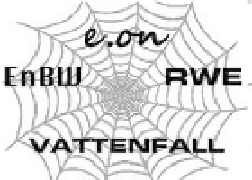Environmental Engineering Reference
In-Depth Information
3
General for Water and Energy”.
To this very day, these forces
have been able to prevent genuine liberalisation with regard
to energy policy, as well as the establishment of an efective
supervisory and regulatory authority.
For whole generations to come, the landscapes ravaged
by unrestrained energy policies will stand out as conspicuous
monuments to the ruthless exploitation and desire for further
conquests of the RWEs, E.ONs, EnBWs, Vattenfalls and Co. These
supra-regional multi-utility companies are supported legally and
politically by the billions of euros of tax-exempt accrued liabilities
available to the atomic power industry. These multi-utility
companies can use this capital income unrestrictedly, for example,
to buy out rivals or for breaking into new markets. At the same
time, decentralised renewable power supplies are being depicted
in a defamatory manner as a means of exploiting the public at large.
3
The Energy Industry Act of 1935 restructured the German energy sector and
laid down the framework conditions for a cheap and secure energy supply,
in order to prevent any detrimental efects on the national economy which
competition might have. Local authority districts were controlled by the
Ministry of the Interior, and private companies by the Ministry of Economic
Afairs. From 1938 to 1941, the German cabinet did not come together at
all. At the height of Hitler's power and only one month after he launched his
campaign to invade Russia, the Office of Inspector General for Water and
Energy was created and the government ministers hitherto responsible for the
energy sector read in the newspapers that they had been replaced, first by
Dr Fritz Todt and later Albert Speer. The energy supply industry in post-war
West Germany was structured according to the 1935 law, which provided for
monopolies in power generation, transmission, distribution and supply. The
Inspector General, however, was retained in the form of an inconspicuous
footnote. This chapter has not yet been reappraised and so this relic lives on.
After the war there were 11 Verbundgesellschaften (high-voltage network
associations) in West Germany. Prior to market “liberalisation” in 1998, about
1 000 electrical utilities existed, 8 of which were involved in large-scale power
generation and high-voltage transmission and about 80 in regional distribution.
After “liberalisation”, however, only 4 large companies existed in Germany.



Search WWH ::

Custom Search